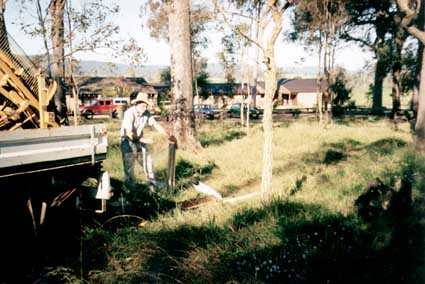Kurosols are also known as a type of podsolic or duplex soil with a definite change between the A and the bleached B horizon.
Profiles 14 (Glendarra Regeneration Area) and 15 (Glendarra Hunter Catchment Management Trust) provide an interesting comparison between cultivated areas and native vegetation areas of the same soil type.
This area (site 14) was taken out of agricultural production in 1978 but profile 15 is from an area only recently fenced off from livestock. They have the same general history but site 14 has had more time to recover from grazing pressure and has returned to native vegetation.
Compare the topsoil at each site. This profile has an ideal soft and fluffy surface soil with abundant plant roots whereas at site 15 the A1 horizon sets hard when dry. Site 15 was waterlogged at the top of the B horizon when sampled but site 14 wasn’t. Soil at site 14 has much better structure than the soil at site 15.
On Tocal we find these:
- are problem soils
- are found on rolling slopes and crests and on old high terraces
- have parent material of weathered sedimentary rocks - sandstone/conglomerate
- support native vegetation of spotted gum forest
- can show dramatic increase in productivity with high inputs.

Profile description
- 0cm: A1 horizon. Dark greyish brown loamy sand. Trace of gravel, soft and fluffy surface soil, abundant plant roots, good drainage, pH 4.4
- 12cm: A1 (gravelly). Same colour and texture as above, increase in gravel content to 60%, rounded and angular gravel, plant roots common, good drainage.
- 22cm: A2 horizon. Very light greyish brown sandy loam. Moderate amounts of gravel, massive structure, drainage fair, large horizontal burnt plant root but no fine plant roots, pH 4.8
- 45cm: B horizon. Yellowish grey medium clay. Moderate to heavy amounts of gravel, soil is tough and dense, cemented in dry state, shows slight dispersion, burnt horizontal plant roots but no fine roots, pH 4.5
Tocal newsletter
Want to find out about news, events, courses and publications?

